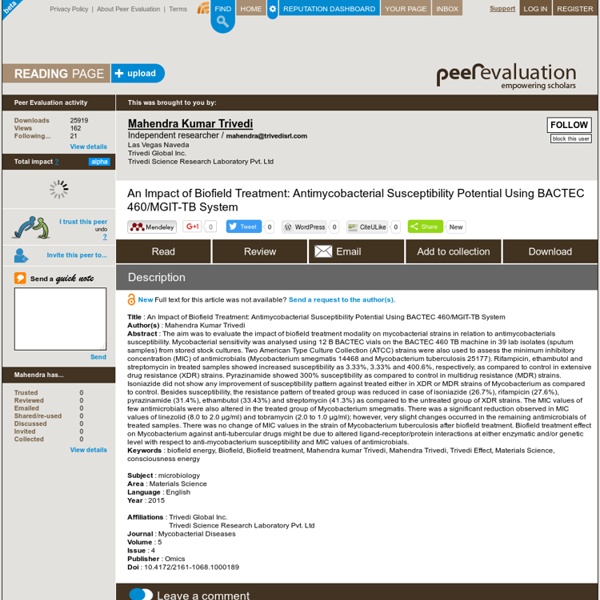Antimycobacterial Susceptibility Testing of Anti-tubercular Drugs
Title: An Impact of Biofield Treatment: Antimycobacterial Susceptibility Potential Using BACTEC 460/MGIT-TB System Select license: Creative Commons Attributions-NonCommercial-ShareAlike Updated: November 19th, 2016 Abstract: The aim was to evaluate the impact of biofield treatment modality on mycobacterial strains in relation to antimycobacterials susceptibility.
Study of XRD & MDR Strains of Mycobacterium
Description The aim was to evaluate the impact of biofield treatment modality on mycobacterial strains in relation to antimycobacterials susceptibility. Mycobacterial sensitivity was analysed using 12 B BACTEC vials on the BACTEC 460 TB machine in 39 lab isolates (sputum samples) from stored stock cultures. Two American Type Culture Collection (ATCC) strains were also used to assess the minimum inhibitory concentration (MIC) of antimicrobials (Mycobacterium smegmatis 14468 and Mycobacterium tuberculosis 25177). Citation Information Mahendra Kumar Trivedi.
XRD Analysis Technique - Evaluation of Biofield Energy
The results obtained on various metallic, ceramic and polymer powders given in subsequent pages are inconceivable and indicate the following facts; 1. Mr.Trivedi’s thought transmission had changed the distance between atoms in the unit cell of a crystal to a maximum of 3.9% and minimum of 0.66 % while the unit cell volume showed a maximum change of 7.79% and a minimum of 1.86%. This means that the powder particle is either elongated or compressed by an amount greater than 0.2% which is normally considered as elastic limit for most solids. These results indicate that the crystal unit cell had undergone permanent compression or elongation (plastic deformation) without changing its structure which is impossible as per current knowledge. 2. 3. 4.So far atomic and molecular weights are assumed to be constant. The results are unprecedented and prove that the information field transferred through Mr. X-ray diffraction (XRD) technique is sensitive at the atomic and crystal structure level.
Thermal Analysis (TGA/DTA, DSC) for Biofield Evaluation
There Are Lots Of Exciting Things Happening Here At Trivedi Science. Enter Your Email Address In The Box Below Now To Stay Updated! Thermal Analysis (TGA / DTA, DSC) These are techniques by which the thermal behavior of substances is characterized. The results of thermal analysis indicated that Mr. X Ray Diffraction (XRD) Particle Size Analysis (PSA) Surface Area Determination (BET) Electron Spin Resonance (ESR) Thermal Analysis(TGA / DTA, DSC) Scanning Electron Microscopy(SEM) C-H-N-S-O Analysis Mass Spectroscopy (GC-MS) Organic Compounds Fourier Transform Infrared Spectroscopy (FTIR) UV Visible Spectroscopy (UV-VIS) High Performance Liquid Chromatography (HPLC) Organic Compounds Remote Energy Transmission Publications Conferences Press Releases
Biofield Energy Treatment of Enterobacter Aerogenes
Abstract: Enterobacter aerogenes (E. aerogenes) has been reported as the versatile opportunistic pathogen associated with the hospital infections worldwide. The aim of the study was to determine the impact of Mr. Keywords: Enterobacter aerogenes; Multidrug resistant; Antimicrobial susceptibility; Biofield treatment; Biochemical reactions; Biotyping Introduction Enterobacter is a genus of Gram-negative, rod shaped, facultative anaerobic, and non-spore forming microbes of family Enterobacteriaceae. The biofield is a cumulative outcome of measurable electric and magnetic field, exerted by the human body [11]. Materials and Methods The Two clinical MDR lab isolates (LSs) of E. aerogenes (i.e., LS 45 and LS 54) were procured from stored stock cultures in microbiology lab, Hinduja hospital, Mumbai and stored as per suggested storage conditions until further use. Inoculum preparation The turbidity standard technique using direct inoculation of E. aerogenes was used. Biofield treatment Results 1.
The Trivedi Effect Impact on Patchouli Plant Cultivation
Patchouli (Pogostemon cablin) Control Aromatic plant Treated With The Trivedi Effect® Aromatic plant In a plot area of 64 feet x 8 feet, 100 treated plants of Patchouli (Aromatic plant) were planted. Treated With The Trivedi Effect® Patchouli Crop Even though patchouli (Aromatic plant) plants are grown in the shade and these plants were planted in an open plot directly under the sunlight, the survival rate of the plants was higher than 99%. Treated With The Trivedi Effect® Patchouli after 73 days -03 April 2006 After 96 days – 26 April 2006 Control Patchouli crop The survival rate in the control plants was less than 60-65% and so the population of the plants was scattered.
Vibrio Parahaemolyticus Biochemical Identification
261 Mahendra Kumar Trivedi et al.: Biochemical Differentiation and Molecular Characterization of Biofield Treated Vibrio parahaemolyticus findings of many studies, it was described that the virulent strain of V. parahaemolyticus carries either the gene tdh or trh, or both and transmit through plasmids or insertion elements [9]. thermolabile haemolysin (TLH) encoded with the tlh gene is considered as a species-specific marker in the strains of V. parahaemolyticus [10]. was reported that the tdh gene, marked by a β-type haemolysis [11], was correlated to a urease positive test [12], and served as the marker for pathogenic strains of Vibrio species. As V. parahaemolyticus is an important foodborne pathogen. To reduce the risk of V. parahaemolyticus infection and to ensure the safety aspect of seafood, an alternative strategy can be used. alternative approach that may be useful in that concern. on the bioplasma concept of consciousness in any living organism, the habitats of bioplasma are protein [17].
Hanks Balanced Salt Solution - An Evaluation of Biofield Treatment
Comparative Physicochemical Evaluation of Biofield Treated Phosphate Buffer Saline and Hanks Balanced Salt Medium Phosphate buffer saline (PBS) has numerous biological and pharmaceutical applications. Hank buffer salt (HBS) has been used as a medium for tissue culture applications.



